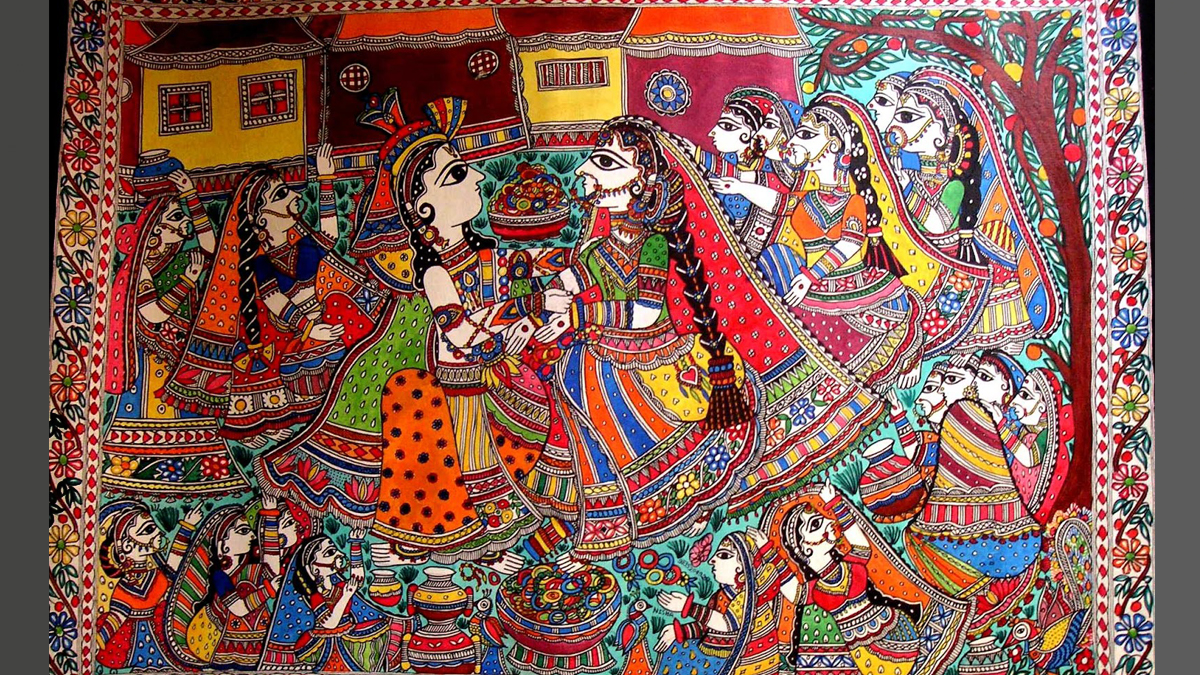
The Power and Promise of Mithila Art: A Gateway to Cultural Identity and Personal Growth
Art is a powerful means of expression, capable of transcending cultural and linguistic barriers. However, to create art that resonates and inspires, one must possess a deep understanding of the subject and a wide breadth of knowledge. The belief that everyone can be a good artist is grounded in the idea that passion and effort can master the skill of creating art. Among the many art forms that exist, Mithila art stands out for its rich cultural heritage and vibrant expression. This traditional art form, originating from the Mithila region of Nepal and India, has evolved over centuries and continues to inspire both artists and connoisseurs alike.
Mithila art is a folk tradition known for its intricate geometric patterns, stylized motifs, and bold use of primary colors. It has been primarily practiced by women in the Mithila region and is deeply rooted in their cultural heritage. Traditionally, Mithila art was created on the walls and floors of homes, but it has since expanded to other mediums such as paper and canvas, reaching a global audience. This art form, also known as Madhubani painting, is more than just a visual expression; it is a narrative that conveys the stories, beliefs, and customs of the Mithila people.
In today’s world, where identity crises are prevalent among the younger generation, the importance of reconnecting with one’s cultural roots cannot be overstated. A strong sense of identity is essential for personal development and well-being. Mithila art offers a unique way for children and youths to explore and celebrate their cultural heritage. Learning this art form allows them to connect with their roots and gain a deeper understanding of their identity. As someone who has dedicated 50 years of my life to Mithila art, I have witnessed the growing interest of young Nepalis in this art form, particularly during my recent visit to Janakpur. The enthusiasm and dedication of these young learners were truly inspiring and highlighted the importance of preserving and passing on this cultural tradition.
Mithila art is not only a beautiful and expressive art form, but it also offers numerous benefits for children and youths. One of the key reasons for teaching Mithila art to the younger generation is its ability to foster creativity and imagination. This free-flowing art form allows individuals to express their thoughts, feelings, and experiences in a unique and personal way. Engaging with Mithila art can help children develop their creativity and imagination, essential skills for personal and professional growth.
Additionally, Mithila art helps children develop fine motor skills. The precise and delicate movements required to create intricate patterns and designs in Mithila art can improve hand-eye coordination and fine motor control. These skills are important not only for artistic endeavors but also for other activities such as writing, drawing, and playing musical instruments.
Furthermore, Mithila art serves as an educational tool that helps children learn about their cultural heritage. Through this art form, they can gain insights into the symbols, motifs, stories, and legends that are integral to Mithila culture. This knowledge helps preserve cultural traditions and fosters a sense of pride and connection to one’s roots.
Mithila art also teaches important values such as patience, concentration, and perseverance. The complexity and challenge of this art form require children to be patient, focused, and persistent—qualities that are essential for success in any area of life. The sense of accomplishment that comes from creating a beautiful Mithila art piece can boost self-confidence and self-esteem, helping children develop a positive self-image and belief in their abilities.
One of the most significant aspects of Mithila art is its role in preserving and transmitting traditional knowledge from one generation to the next. By learning this art form, children and youths can tap into the wisdom of their ancestors and carry it forward into the future. Mithila art encapsulates stories, mythology, rituals, and everyday life, providing valuable insights into the region’s rich cultural tapestry. Through this art form, the collective memory of a community is preserved, ensuring that its traditions and values are not lost with time.
Moreover, Mithila art has the potential to provide economic opportunities for children and youths. As the demand for traditional art forms grows globally, there is a market for Mithila art both domestically and internationally. By learning and mastering this art form, young individuals can preserve their cultural heritage and create livelihoods for themselves. They can become entrepreneurs, artists, or artisans, contributing to their communities’ sustainable development and helping uplift the local economy.
Mithila art also fosters creativity and critical thinking skills in children and youths. As they engage in the process of creating intricate patterns and designs, they develop their artistic abilities and problem-solving skills. Mithila art encourages individuals to think outside the box and find innovative ways to represent their ideas visually. This art form nurtures imagination and promotes originality, allowing young minds to explore their artistic potential and develop their unique voices.
For those interested in teaching their children or youths about Mithila art, numerous resources are available to help them get started. Books, websites, and online courses offer instruction in the basics of Mithila art. Additionally, many cities worldwide offer Mithila art classes and workshops. Exploring Mithila art with children and youths can yield amazing results, fostering creativity, cultural awareness, and personal growth.
The importance of children and youths learning Mithila art cannot be overstated. This traditional art form acts as a bridge between generations, preserving cultural heritage and strengthening the sense of identity. It nurtures creativity, critical thinking, and self-confidence, equipping young minds with essential personal and professional growth skills. Additionally, Mithila art opens doors to economic opportunities, allowing individuals to thrive while preserving their cultural legacy. Our collective responsibility is to promote and support the learning and practice of Mithila art among the younger generation, ensuring the continuity of this invaluable cultural treasure.
The writer is one of the most imaginative artists of Mithila art. Sah, whose works have been rooted in Mithila culture, adds new dimensions to the Mithila culture with Harmony.














Comments